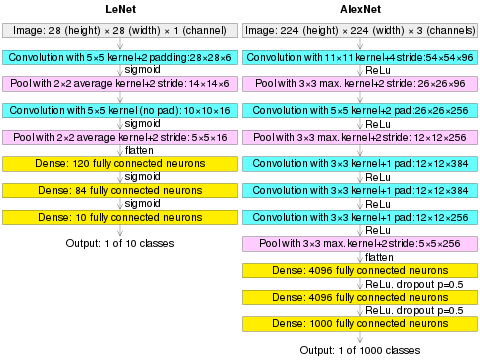

(AlexNet image size should be 227×227×3, instead of 224×224×3, so the math will come out right. The original paper said different numbers, but Andrej Karpathy, the former head of computer vision at Tesla, said it should be 227×227×3 (he said Alex didn't describe why he put 224×224×3). The next convolution should be 11×11 with stride 4: 55×55×96 (instead of 54×54×96). It would be calculated, for example, as: [(input width 227 - kernel width 11) / stride 4] + 1 = [(227 - 11) / 4] + 1 = 55. Since the kernel output is the same length as width, its area is 55×55.)

AlexNet is the name of a convolutional neural network (CNN) architecture, designed by Alex Krizhevsky in collaboration with Ilya Sutskever and Geoffrey Hinton, who was Krizhevsky's Ph.D. advisor at the University of Toronto.[1][2]
The three formed team SuperVision[3] and submitted AlexNet in the ImageNet Large Scale Visual Recognition Challenge on September 30, 2012.[4] The network achieved a top-5 error of 15.3%, more than 10.8 percentage points lower than that of the runner up. The original paper's primary result was that the depth of the model was essential for its high performance, which was computationally expensive, but made feasible due to the utilization of graphics processing units (GPUs) during training.[2]
- ^ Gershgorn, Dave (26 July 2017). "The data that transformed AI research—and possibly the world". Quartz.
- ^ a b Krizhevsky, Alex; Sutskever, Ilya; Hinton, Geoffrey E. (2017-05-24). "ImageNet classification with deep convolutional neural networks" (PDF). Communications of the ACM. 60 (6): 84–90. doi:10.1145/3065386. ISSN 0001-0782. S2CID 195908774.
- ^ Large Scale Visual Recognition Challenge 2012 (ILSVRC2012)
- ^ "ImageNet Large Scale Visual Recognition Competition 2012 (ILSVRC2012)". image-net.org.